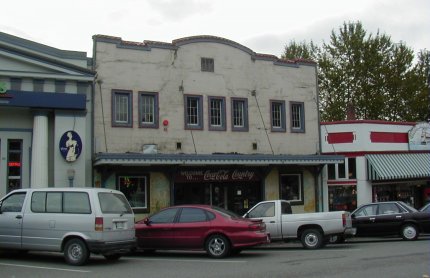

|

Brown (Smith) Theatre - 2/4 Kimball
Snohomish, Washington
First St.
Back to the Washington Original Theatre Installations page

Brown Theatre building, c. 2000. Looking south across 1st St.
The Brown Theatre originally had a 2/4 Kimball (KPO 6784) installed by Sandy Balcom in 1924. The cost was $6,900. The organ was later owned by Dave Markworth of Portland, OR
The theatre building still exists. In late 2000, it was in the process of being converted to an antique mall.
 |
NEW ORGAN SPECIALLY DESIGNED FOR BROWN
Carrying out the completeness of equipment in the new Brown's Theatre is the handsome Kimball organ, installed by C.M. Balcom, technical engineer for the Kimball company. The organ is declared to be the last word in unification, combining under expression every tone of the pipe organ with unlimited variety of orchestra instruments. The big organ was designed especially for the theatre, this featuring the policy of the Kimball company to install organs fitted to meet the acoustics peculiar to each house.
Adaptability of the instrument extends from its customary service interpreting the motion picture to its use as a vaudeville organ. Through deflected shutters the tones of the organ are first conveyed to the stage, then to the auditorium, this featuring being of special benefit to the soloist or chorus. The Brown's Theatre organ gives the performer ample opportunity to synchronize with the organist.
Through the flexibility of the expression chambers each solo stop may be used in accompaniment. From full organ, bringing out the various shadings of an overture, the organist may enter a solo in which the notes of the flute, for instance, stand out. |
The various parts of the organ are housed in concrete, sound proof chambers to the right and left of the proscenium arch. To the observer, the control parts of instrument resemble generally a telephone relay frame. Hundreds of wires, emerging from a cable that connects with the organ in the orchestra pit, branch out to the various pipes and parts of the instrument.
Despite the huge size of the organ, there is a minimum of vibration. The organ is built to give the theatrical operator and the organist the service desired and according to its builder, there is no chance of trouble occurring within the organ itself to hinder the playing of the instrument.
Deagan's artist special percussions are used with the organ. Ludwig & Ludwig traps and drums are found among the orchestral units.
The entire instrument uses a blower unit driven by a five horsepower motor generating electric current which in turn supplies the action for the organ.
Mr. Balcom, who installed the organ, is an expert said to be without a peer in the United States, having worked with Hope Jones, originator of the unified organ when he first began the manufacture of these musical innovations. |
|
|




